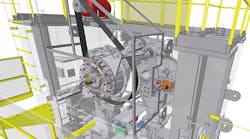The B2B software industry is accelerating its transition to software-as-a-service, while industries increasingly adopt 3-D parametric modeling, simulation and collaboration solutions — transforming the way architects, designers, drafters, detailers, engineers and many other professionals design and make things.
This begs the question: Where is more traditional Computer Aided Design software heading? There are three big evolutions shaping the future of CAD software and influencing CAD users’ expectations. These entail enablement of a highly personalized experience, seamless and expanded collaboration, and universal access to game-changing insights.
Let’s take a closer look at important trends and their implications for users.
The Growing Importance of Personalization
The ability to easily customize design and drafting software is key to the perceived utility of these important tools. In the traditional desktop software environment, most software vendors have added features and expanded their portfolios over the years in an effort to address the needs of the largest number of users. This has resulted in complex and feature-rich products with a huge number of available commands that most users never touch. On the flipside, an overwhelming majority of users need additional features that the application doesn’t provide out of the box.
Thankfully, this time will soon be over.
The future lies in providing users with platform technologies that can easily be configured and augmented. Within the product, it will be simple for users to discover and test add-ons and third-party vertical applications complementing a base product. Think of it as plain yogurt: you can add whichever toppings you choose.
Adding updated features to your existing workflow and upgrading software will be seamless. This will be true not only for features, user interfaces, and tools, but also for training and learning materials, content, additional subscription benefits, and more — all of which will be recommended or served at the right time based on the user’s design intent and preferences.
The shift toward a subscription model and cloud-based services will allow software vendors to become much more intelligent and agile in terms of offering what’s right for each user and organization, while also helping them gradually and seamlessly adopt the next level of technology. At any time, depending on the project requirements or skills, users will be able to adapt their software to their needs. In other words, their CAD tools will evolve both with them and for them.
Improved Collaboration Will Occur in the Cloud
Collaboration challenges are as old as the design and engineering space. These challenges remain one of the main sources of pain for today’s CAD users. Indeed, there are routinely multiple stakeholders — often hundreds — involved in the design process from different companies. Thousands of revisions get performed asynchronously throughout the lifecycle of a project. And with dozens of so-called collaboration tools often being used in parallel within a company or project ecosystem, it’s little wonder there are problems.
Now, imagine a world where collaborating is more streamlined. The move to cloud-based design technology will free up some of the constraints that arise when only a single user can work on a file at a time. A world where connecting different tools is seamless and file formats and software releases won’t matter or exist, freeing users from the challenges of versions, compatibility and interoperability. There will be one version, one platform and one design, and it will be maintained in the cloud.
Another accelerating factor is the evolution of how users think about collaboration. In the world before CAD, collaboration was a slow, expensive process. Making a design change required using razor blades to scrape ink lines from acetate sheets. As a result, there wasn’t any room for iterative collaboration. However, the advent of design and drafting software changed that by reducing the time and cost to change a design, enabling far greater degrees of collaboration.
Something similar is occurring with cloud- and web-based CAD. Users will gain the ability to work simultaneously on a single model, have access based on design element, or access playback — like in a video editing tool — of the history and ramifications of changes made throughout the entire project.
But when we look at how collaboration will evolve, there is a much bigger disruption that may be on the horizon as a result of moving to cloud-based technology. The power of the crowd is really where the new generation of CAD will find its potential.
At some point, there will be digital marketplaces and social networks that will allow CAD users to connect with one another from within their application, share — and eventually monetize best practices, content, add-ons, and engineering solutions. There will most likely be a place where designers working on similar projects or products will be able to agree on certain specifications and group orders to suppliers and manufacturers, thereby taking the unit cost down while ensuring a more predictable and stable demand for suppliers.
Cloud-based CAD will make it possible for users to exchange the recipes that compose the engineering world, tapping into much more intelligence than what the most advanced level of software or artificial intelligence can provide.
Universal Access to Rich Data and Transformational Insights
Most users already expect access to their design data any time, anywhere, in a way that is device and platform agnostic. The real value of having data stored in the cloud will come from the insights that will be provided back to users, design team managers and executives. For example, one challenge for users is not being able to reuse old designs, as old data isn’t well archived, or is hard to search (or when knowledge leaves with employees). Analyzing data from past projects will provide users with contextual content, like blocks or templates, as people design.
Almost any question you could ask about a project will have an answer: How many individuals in a department touched the model? How many hours have been spent on the project across different disciplines and tasks? What were the friction points, and where can workflows be improved?
Such insights will help with strategic decisions around resource allocation, innovation, IT investments, talent acquisition and development. This will put more power in the hands of those overseeing CAD technology, such as CAD managers and system engineers.
This data will still be proprietary to the companies and users creating it.
Today, there are already very strict restrictions about data protection in most countries, and as the industry moves to the cloud, more regulations will emerge and bring additional protection. One thing is certain: companies embracing the cloud early on for their design and collaboration applications will have a significant competitive advantage. Some large companies have already made the leap and are pressuring CAD software vendors to move faster.
There is no doubt, the shift to a software-as-a-service model will accelerate the delivery of an entirely new and delightful experience for users, while profoundly changing the way they collaborate and do their work.
Rob Maguire is the AutoCAD product line director at Autodesk. He is responsible for overseeing the company’s flagship product line, AutoCAD, the world’s leading design and drafting solution. Rob has more than 17 years of experience in engineering and project management roles. Rob is passionately engaged in new technology, most recently 3-D laser scanning and photogrammetry requirements gathering. He can be reached at [email protected].





